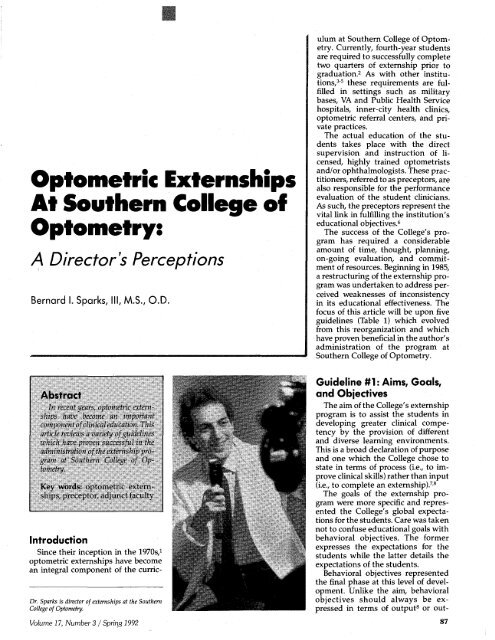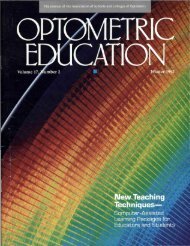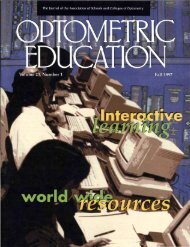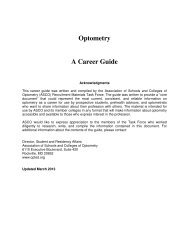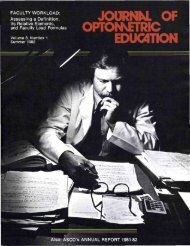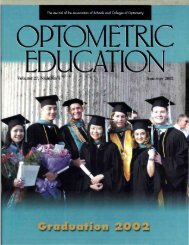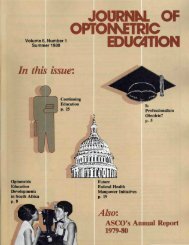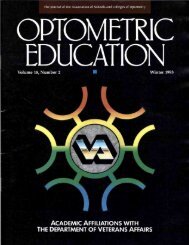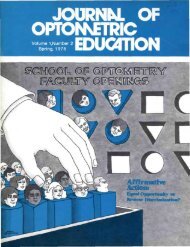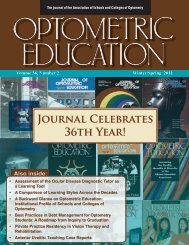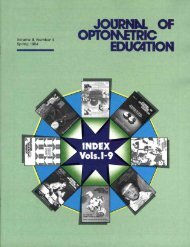Spring 1992, Volume 17, Number 3 - Association of Schools and ...
Spring 1992, Volume 17, Number 3 - Association of Schools and ...
Spring 1992, Volume 17, Number 3 - Association of Schools and ...
You also want an ePaper? Increase the reach of your titles
YUMPU automatically turns print PDFs into web optimized ePapers that Google loves.
Optometric Externships<br />
At Southern College <strong>of</strong><br />
Optometry:<br />
A Director's<br />
Bernard I. Sparks, III, M.S., O.D.<br />
Perceptions<br />
ulum at Southern College <strong>of</strong> Optometry.<br />
Currently, fourth-year students<br />
are required to successfully complete<br />
two quarters <strong>of</strong> externship prior to<br />
graduation. 2 As with other institutions,<br />
35 these requirements are fulfilled<br />
in settings such as military<br />
bases, VA <strong>and</strong> Public Health Service<br />
hospitals, inner-city health clinics,<br />
optometric referral centers, <strong>and</strong> private<br />
practices.<br />
The actual education <strong>of</strong> the students<br />
takes place with the direct<br />
supervision <strong>and</strong> instruction <strong>of</strong> licensed,<br />
highly trained optometrists<br />
<strong>and</strong>/or ophthalmologists. These practitioners,<br />
referred to as preceptors, are<br />
also responsible for the performance<br />
evaluation <strong>of</strong> the student clinicians.<br />
As such, the preceptors represent the<br />
vital link in fulfilling the institution's<br />
educational objectives. 6<br />
The success <strong>of</strong> the College's program<br />
has required a considerable<br />
amount <strong>of</strong> time, thought, planning,<br />
on-going evaluation, <strong>and</strong> commitment<br />
<strong>of</strong> resources. Beginning in 1985,<br />
a restructuring <strong>of</strong> the externship program<br />
was undertaken to address perceived<br />
weaknesses <strong>of</strong> inconsistency<br />
in its educational effectiveness. The<br />
focus <strong>of</strong> this article will be upon five<br />
guidelines (Table 1) which evolved<br />
from this reorganization <strong>and</strong> which<br />
have proven beneficial in the author's<br />
administration <strong>of</strong> the program at<br />
Southern College <strong>of</strong> Optometry.<br />
Abstract<br />
In recent year*, optometric externships<br />
lunv become an important<br />
component <strong>of</strong> clinical education.Thh<br />
article nviezvs a variety <strong>of</strong> guidelines<br />
which have pnnvn successful in the<br />
administration <strong>of</strong> the externship program<br />
at Southern College <strong>of</strong> Optometry.<br />
Key words: optometric externships,<br />
preceptor, adjunct faculty<br />
Introduction<br />
Since their inception in the 1970s, 1<br />
optometric externships have become<br />
an integral component <strong>of</strong> the curric-<br />
Dr. Sparks is director <strong>of</strong> externships at the Southern<br />
College <strong>of</strong> Optometry.<br />
<strong>Volume</strong> <strong>17</strong>, <strong>Number</strong> 3 / <strong>Spring</strong> <strong>1992</strong><br />
a<br />
\,<br />
Guideline #1: Aims, Goals,<br />
<strong>and</strong> Objectives<br />
The aim <strong>of</strong> the College's externship<br />
program is to assist the students in<br />
developing greater clinical competency<br />
by the provision <strong>of</strong> different<br />
<strong>and</strong> diverse learning environments.<br />
This is a broad declaration <strong>of</strong> purpose<br />
<strong>and</strong> one which the College chose to<br />
state in terms <strong>of</strong> process (i.e., to improve<br />
clinical skills) rather than input<br />
(i.e., to complete an externship). 78<br />
The goals <strong>of</strong> the externship program<br />
were more specific <strong>and</strong> represented<br />
the College's global expectations<br />
for the students. Care was taken<br />
not to confuse educational goals with<br />
behavioral objectives. The former<br />
expresses the expectations for the<br />
students while the latter details the<br />
expectations <strong>of</strong> the students.<br />
Behavioral objectives represented<br />
the final phase at this level <strong>of</strong> development.<br />
Unlike the aim, behavioral<br />
objectives should always be expressed<br />
in terms <strong>of</strong> output 8 or out-<br />
87


